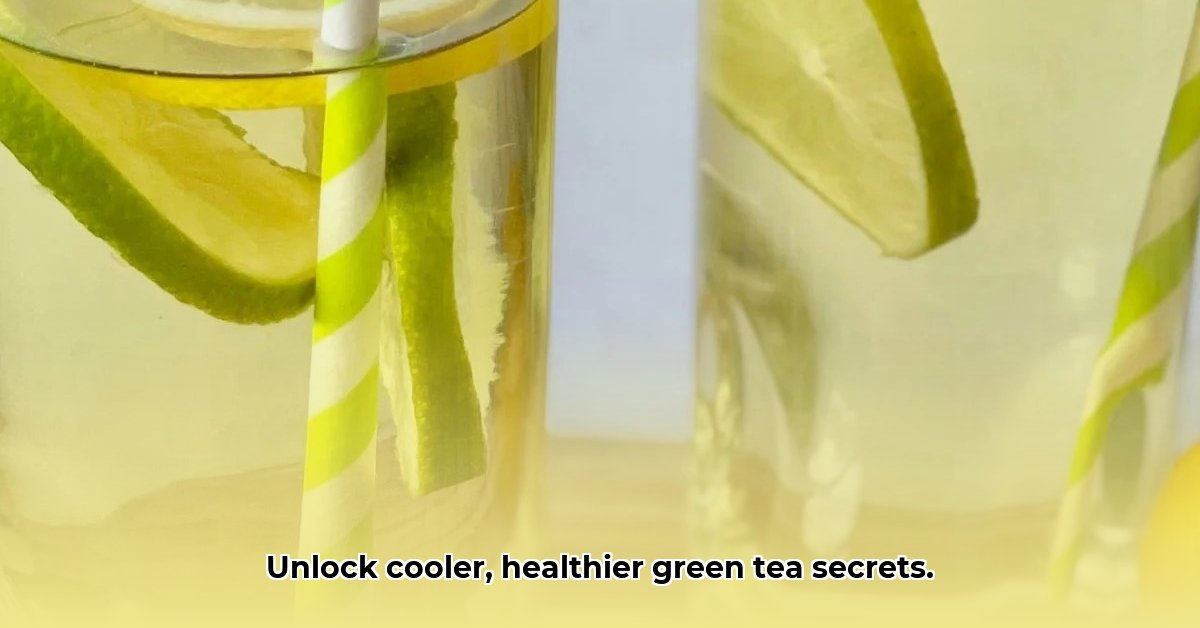
Ready to unlock a smoother, tastier, and potentially healthier way to enjoy green tea? Cold brewing is your secret weapon. This guide will walk you through the process, from selecting the right tea to optimizing brewing time, and explore the potential health benefits—along with what we still need to learn.
The Magic of Cold Brewing: Why It's Superior
Why choose cold brewing over the traditional hot water method? Hot brewing is a rapid extraction, often leading to a bitter taste due to the release of tannins (compounds that cause astringency). Cold brewing, on the other hand, is a gentler process. This slow extraction minimizes tannin release, yielding a smoother, more refined flavor profile. Additionally, cold brewing may preserve a higher concentration of beneficial antioxidants and vitamins, although further research is needed to confirm this quantitatively. Don't just take our word for it; try it yourself and experience the difference!
A Taste Transformation: Smooth, Subtle, and Simply Delicious
Cold-brewed green tea offers a remarkably smoother taste than its hot-brewed counterpart. This makes it perfect for those new to green tea or those who find traditional hot brews too intense. Imagine the difference between a bold espresso and a smooth, iced latte—both satisfying, but with distinct flavor profiles. Cold brewing reveals the subtle, often sweeter notes often masked by bitterness in hot-brewed green tea.
Brewing Your Perfect Cup: A Step-by-Step Guide
Crafting cold brew green tea at home is surprisingly easy. Follow these straightforward steps:
Tea Selection: Choose a high-quality green tea. Sencha, Gyokuro, or even matcha blends will all offer unique results. Experiment to find your favorite! (Different green tea varieties offer different flavor profiles.)
Ratio Mastery: Start with 1 tablespoon of loose leaf tea (or 2-3 tea bags) per 8 ounces of cold, filtered water. Adjust the ratio to achieve your desired strength. (A higher leaf-to-water ratio yields a stronger brew.)
The Gentle Steep: Place the tea in a clean jar or pitcher, add the cold water, stir gently, and seal tightly. Refrigerate for at least 6-8 hours, or even overnight for a more intense flavor. (Over-steeping is less of a concern with cold brewing, but excessively long steeping times can still introduce bitterness.)
Strain and Savor: Once steeped, strain the tea using a fine-mesh sieve or cheesecloth to remove the leaves. Enjoy your brew chilled, at room temperature, or slightly warmed. Feel free to experiment with additions like lime, lemon, or a touch of honey. (Adding citrus enhances the bright, refreshing character of cold brew green tea.)
Potential Health Benefits: Beyond the Delicious Taste
While the exact differences require further research, many believe cold brewing preserves a higher concentration of beneficial compounds in green tea, including antioxidants and vitamins. These antioxidants fight free radicals, and some suggest potential links to improved cardiovascular health, immune function, and overall well-being. However, it's crucial to remember that while promising, these are potential benefits, not guaranteed outcomes. Cold brew green tea complements a healthy lifestyle—it's not a miracle cure. "The antioxidants in green tea are well-documented, but more research is needed on the specific impact of cold brewing on their bioavailability," says Dr. Anya Sharma, Research Scientist at the Institute for Food Science and Technology.
Cold Brew vs. Hot Brew: A Comparison
| Feature | Cold Brew | Hot Brew |
|---|---|---|
| Flavor | Smooth, less bitter, delicate | More intense, potentially bitter |
| Caffeine Content | Generally lower | Generally higher |
| Antioxidants | Potentially higher (research ongoing) | Potentially lower (research ongoing) |
| Brewing Time | 6-8 hours or more | 2-5 minutes |
| Brewing Ease | Very simple | Requires more attention |
How to Optimize Cold Brewing Time for Different Green Tea Types
Optimizing brewing time is essential for unlocking the best flavor from different green teas. Japanese green teas, often more delicate, generally require shorter steep times compared to more robust Chinese varieties. Experimentation is key!
Tea Type Matters: A Brewing Guide
The type and origin of your green tea significantly impact the ideal brewing time. Delicate Japanese Sencha benefits from shorter steeps (15-20 minutes), while more robust Chinese greens might need 4-6 hours, or even longer.
Fine-Tuning Your Brew
Tea Selection: Choose your green tea, considering its type (Sencha, Gyokuro, etc.).
Water Choice: Use filtered water for the purest flavor.
Leaf-to-Water Ratio: Begin with 1 teaspoon of loose leaf tea or one tea bag per 8 ounces of water. Adjust to your liking.
Steep Time Experimentation:
- Japanese Green Teas (e.g., Sencha, Fukamushi Sencha): Start with 15-20 minutes.
- Other Green Teas (e.g., Chinese Green Teas, Gunpowder Green Tea): Begin with 4-6 hours. Increase gradually for stronger flavor.
Taste-Testing: Taste your brew after the initial steep and adjust accordingly.
Refrigerate: Refrigerate your brew post-steep to prevent over-extraction and preserve flavors.
Troubleshooting
- Too Bitter: Reduce steeping time.
- Too Weak: Increase steeping time or leaf-to-water ratio.
- Cloudy Brew: Use a finer mesh strainer.
Embrace the experimentation! Discover your perfect cold brew green tea recipe.